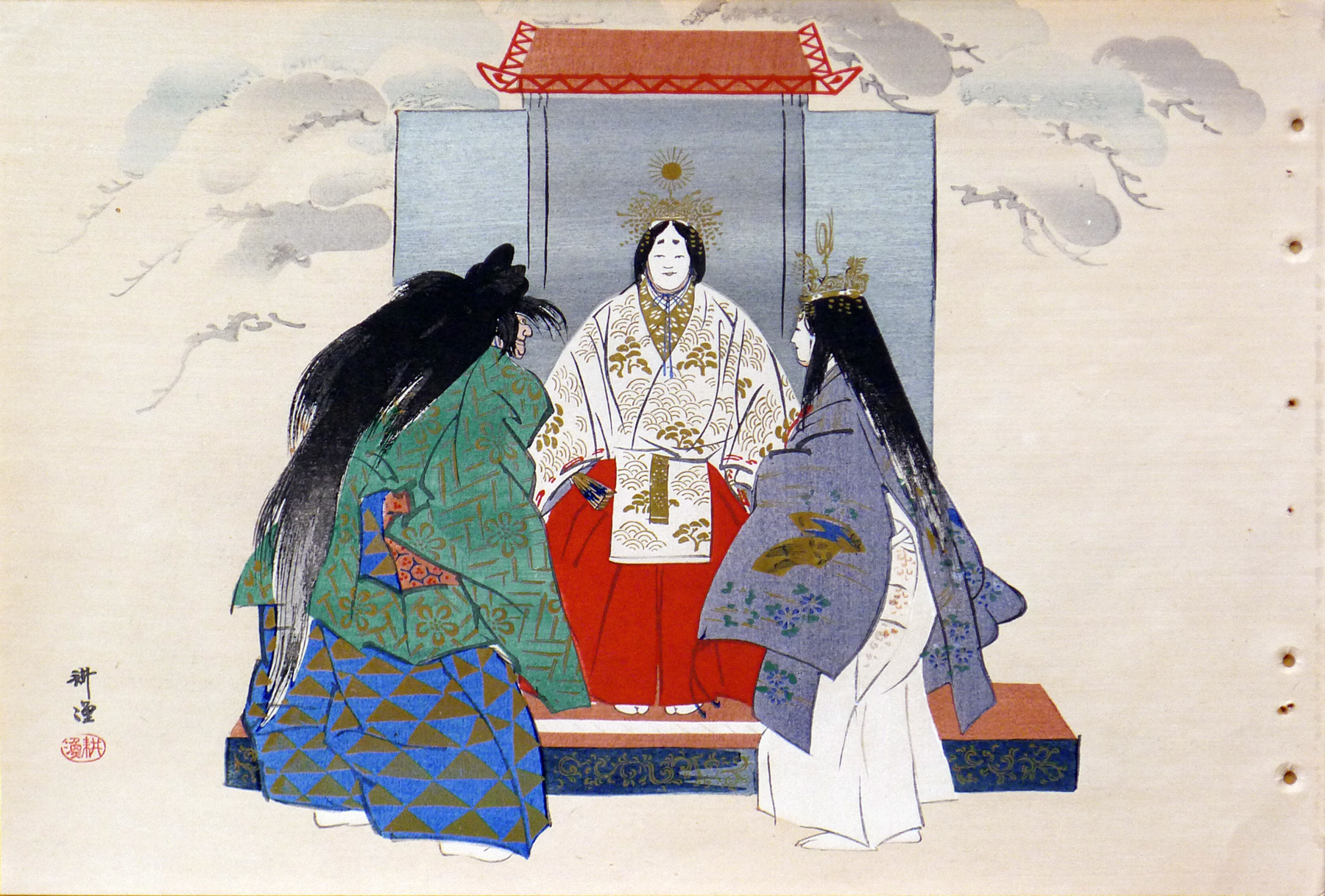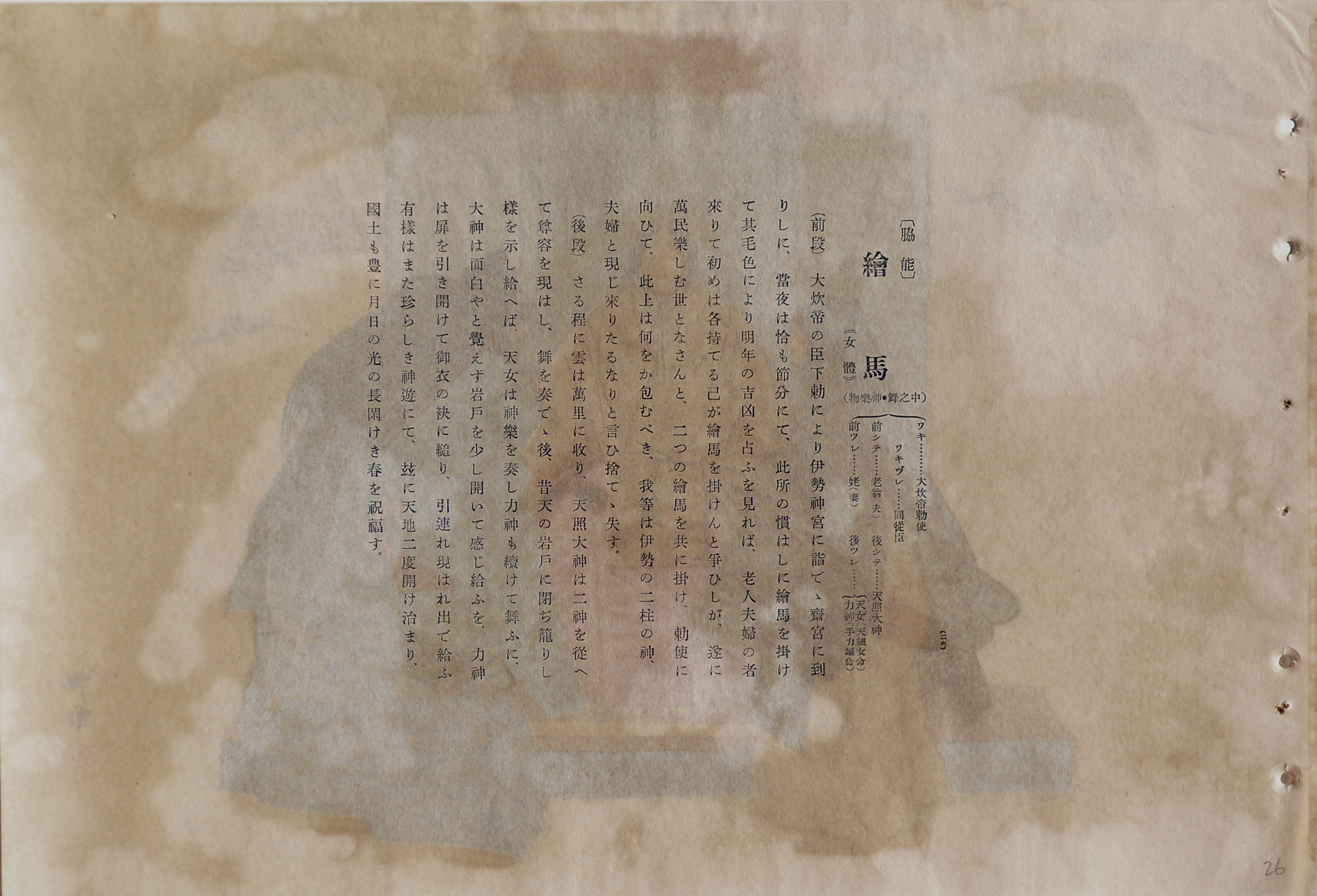About This Print
Number 261 of 200 prints issued as part of the series Nōga taikan (Encyclopedia of Noh Plays) depicting a scene from the play Ema (author unknown). This print still maintains its semi-transparent cover sheet providing information on the play and its characters. The cover sheet notes, in the upper right hand corner, that this play is a waki-noh 脇能.2cover sheet
click on image to see detail
Tsukioka Kōgyo (1869-1927) depicted this print in each of his three major series on Noh. To view these prints see Nōgakuzue, Ema and Nōgaku hyakuban, Ema.
1 Number appears in the lower right hand of the cover sheet.
2 The first Noh play is called "Waki" Noh. "Waki" means "side" and is called that because it comes to the side of the Okina play. This category of play usually shows gods and is not very dramatic, but is more like auspicious ceremony. Many of the short songs performed independently come from these plays. (definition taken from Japanese Traditional Music, Columbia Music Entertainment, Inc. website http://jtrad.columbia.jp/eng/n_yokyoku.html
click on image to see detail
Tsukioka Kōgyo (1869-1927) depicted this print in each of his three major series on Noh. To view these prints see Nōgakuzue, Ema and Nōgaku hyakuban, Ema.
1 Number appears in the lower right hand of the cover sheet.
2 The first Noh play is called "Waki" Noh. "Waki" means "side" and is called that because it comes to the side of the Okina play. This category of play usually shows gods and is not very dramatic, but is more like auspicious ceremony. Many of the short songs performed independently come from these plays. (definition taken from Japanese Traditional Music, Columbia Music Entertainment, Inc. website http://jtrad.columbia.jp/eng/n_yokyoku.html
The Play - Ema
Source: A Guide to No, P.G. O'Neill, Hinoki Shoten, 1929, p. 26-28.An Imperial emissary on his way to the Great Shrines of Ise stops overnight at Saikū nearby as it happens to be the last day of winter and he hopes to see something of the votive tablets which are said to be hung up there during that particular night to foretell the fortunes of the coming year, a white one indicating sunny weather and a black one rain. He meets an old couple with such tablets who, after some discussion, agree to put up one of each kind to signify good fortune for everyone. They then disappear into the darkness after telling him that they are in fact two of the gods of Ise. In the second part Amaterasu, the Sun-goddess, appears with the goddess Uzume and the god Tajikarao and performs a dance. The three of them then depict the ancient story of Amaterasu’s withdrawal into a cave: as the world is plunged into darkness by her disappearance, the other gods dance and make merry and eventually succeed in enticing her out again by arousing her curiosity.
Print Details
| IHL Catalog | #727 |
| Title | Ema 絵馬 (The Votive Tablets) |
| Series | Nōga taikan 能画大鑑 (Encyclopedia of Noh Plays or A Great Mirror of Noh Pictures or A Great Collection of Noh Pictures) |
| Artist | Tsukioka Kōgyo (1869-1927) |
| Signature | Kōgyo |
| Seal |  Kōgyo seal Kōgyo seal |
| Date | July 5, 1926 |
| Edition | unknown |
| Publisher | Seibi Shoten (or Seibi Shoin), Tokyo |
| Carver | Uchida Eikichi |
| Printer | Yoshida Takesaburō |
| Impression | excellent |
| Colors | excellent |
| Condition | excellent; one pin hole upper left of image; binding holes right side |
| Genre | ukiyo-e |
| Miscellaneous | |
| Format | oban yoko-e |
| H x W Paper | 10 x 14 3/4 in. (25.4 x 37.5 cm) |
| Collections This Print | |
| Reference Literature |



